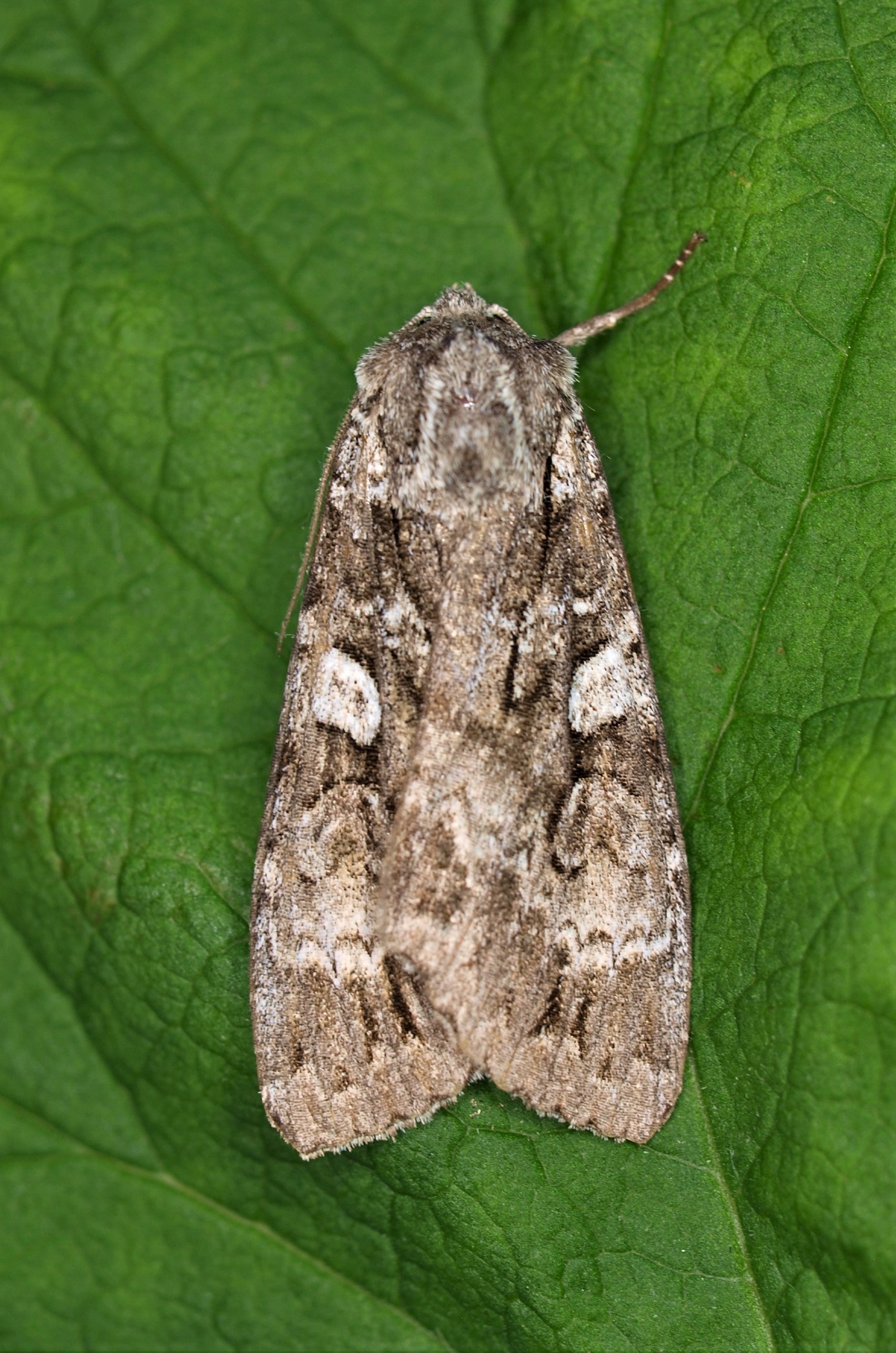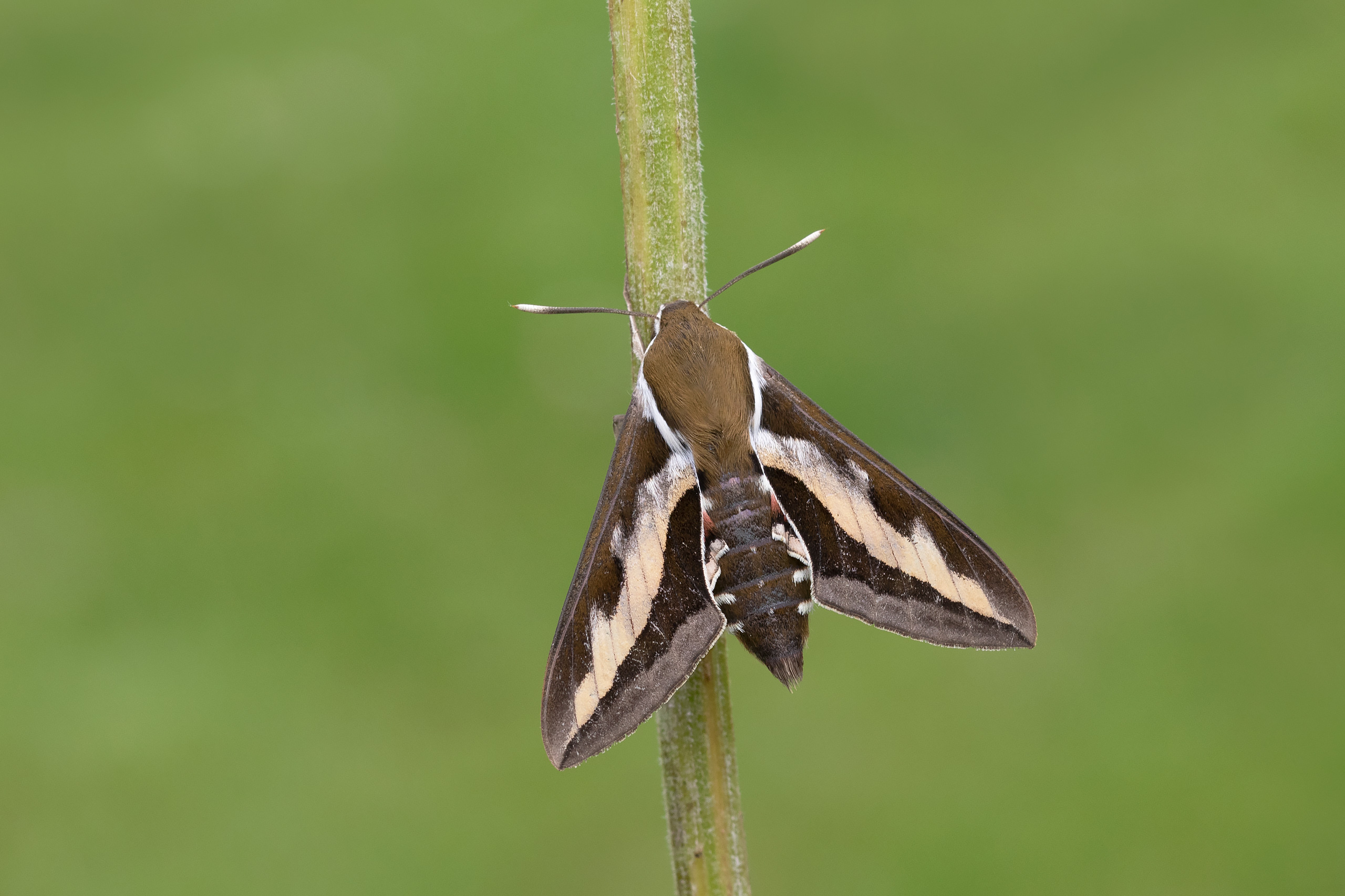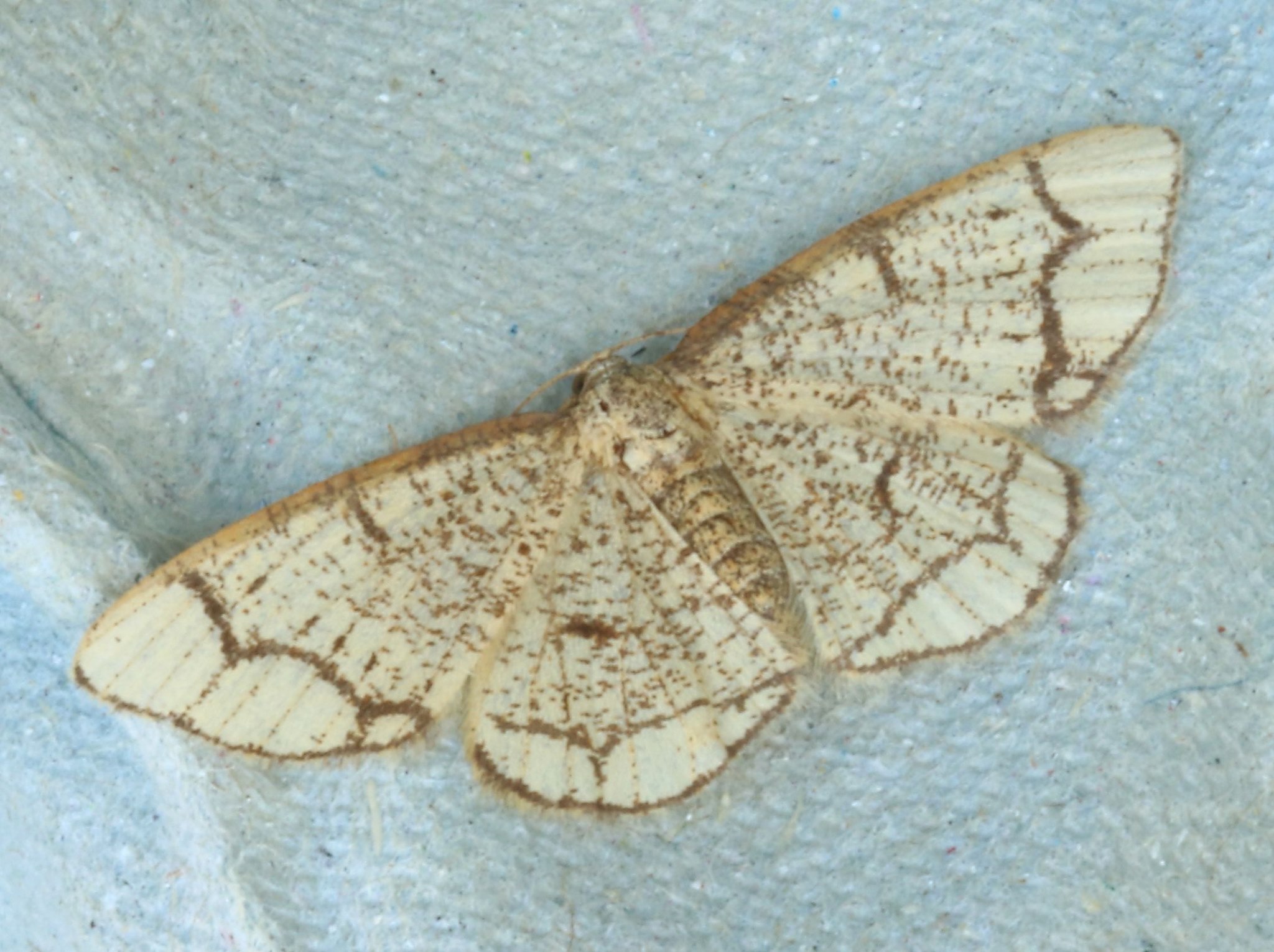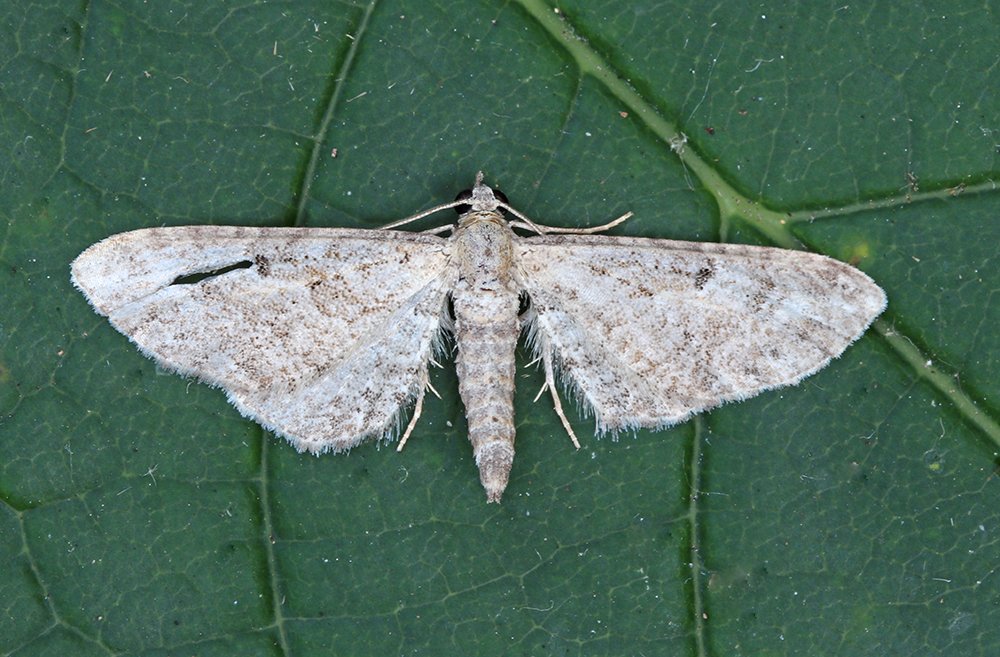After a slow start to the invertebrate year, June saw 2021 gradually right itself, and moth and butterfly recorders welcomed a further improvement in conditions in July that coincided with the traditional peak in the UK season.
Migrants
The month started with warm southerlies as tropical air moved up from Iberia and Canaries, bringing a few decent migrants to moth traps in the south, the best-travelled of which was probably a surprise specimen of the Pyralid Etiella zinckenella at Over, Cambridgeshire, on 3rd. From closer by in the same period, came several Rannoch Loopers – in Suffolk, Hollesley, on 3rd, and Hertfordshire the following day – along with a Small Marbled at Pennington, Hampshire, on 3rd and a Latin at Maenporth, Cornwall, on 4th.

Great Brocade, Upton, Norfolk (Graham Stocker).
Conditions mid-month gave things a different flavour as warm winds from the east brought a sustained hot spell and a decent arrival of Great Brocade, following only a handful of records last year. These were recorded on 16th (Upton, Norfolk), 17th (Theberton, Suffolk, and St Margaret's at Cliffe, Kent), 21st (Holme, Norfolk, and Lealholm, Yorkshire) and 28th (Carlisle, Cumbria).
Bedstraw Hawkmoths also appeared in good numbers throughout the month and enjoyed an uptick in arrivals in the same period, mostly in the east as is typical. Some made it inland: to Higham Ferrers, Northamptonshire, on 3rd; Wheathampstead, Hertfordshire, on 8th; Helpston, Cambridgeshire, on 15th; Cheltenham, Gloucestershire, on 26th; and to the far north too, with records in the Outer Hebrides on 10th and Unst, Shetland, on 12th. It was a quieter month for the related Striped Hawkmoth, though, being between broods, with just a couple of records, including ones inland in Leicester on 8th and Maidenhead, Berkshire, on 20th. Another headliner from last month, Beautiful Marbled, was also between broods with just one record at Kirby Cross, Essex, on 18th.

Bedstraw Hawkmoth, Helpston, Cambridgeshire (Josh Jones).
The latter part of the month brought fresh migrants too, with a good scatter of Splendid Brocades (one in Suffolk, two in Kent and one in Dorset), and the scarce Pyralid Loxostege sticticalis (Cornwall, Dorset and Suffolk). This period was also notable for high counts of Yponomeuta species, particularly Willow Ermine, some of which seem likely to have originated from the continent, aided by the earlier easterlies. This species was recorded in good numbers across a large area of the south-east, where it was new to many recorders, while there were some impressive counts, including an estimated 300 at Highworth, Wiltshire, on 21st.

Loxostege sticticalis, Upwey, Dorset (Paul Harris).

Willow Ermine, Elkesley, Nottinghamshire (Paul Coombes).
Away from the obvious headlines, July garnered a good variety of scarce migrants, including a Pale Shoulder at Heveningham, Suffolk, on 25th, a Dusky Marbled Brown at Densole, Kent, on 20th, and a Druid at Eastleigh, Hampshire, on 18th. A stunning Ringed Border was at Southampton on 20th, with another at Osborne, Isle of Wight, on 23rd.

Ringed Border, Southampton, Hampshire (Ian Harding).
Migrant micros were mostly represented by Pyralids and Crambids in July, with a record of Diasemia reticularis a surprise inland at Llanfallteg, Carmarthenshire, on 25th, while Psammotis pulveralis was seen at Whitstable, Kent, on the same night, with Sciota rhenella nearby at Sandwich Bay on 19th and Diasemiopsis ramburialis at Portland Bird Observatory, Dorset, on 25th. The latter was part of an extremely impressive catch that also included a migrant Ethmia bipunctella, Cydia amplana and just Dorset's second Rose Plume. The latter species is much sought-after and can be hard to pin down, but was recorded at several sites in its Thames Basin stronghold during the month. Perhaps the most exciting micro of the month was not a Pyralid though, but another newly arrived Caloptilia species – Caloptilia fidella, first caught at Butley, Suffolk, on 18th, followed by another at Hollesley on 24th. Mines were then found on Hop at the original site a few days later, making it a lovely and not overdue addition to our fauna following its steady expansion through north-west Europe, having first been recorded in Belgium and The Netherlands in 2009 and 2010 respectively.

Rose Plume, Canvey Wick, Essex, (Tom Lantaff).
There were also a couple of interesting adventive records in July, with a lovely fresh Sclerocona acutellus to light in Peterborough on 5th new to Huntingdonshire, probably courtesy of thatching operations nearby. Of murkier origins were several Brassy Waved Umber bred from larvae on an olive tree purchased at Lerwick, Mainland, Shetland, mid-month. The trees originated in the Isles of Scilly, raising the possibility that these larvae were the offspring of a genuine migrant to the islands – though there seems to be little possibility of this southern European species ever colonising as far as the Northern Isles.

Sclerocona acutellus, Peterborough, Cambridgeshire (Jonathan Newman).
Residents
The month provided further evidence of the continued expansion and establishment of several species in the south of England. Although Jersey Mocha is now an expected sight in some parts of the south coast in July, several individuals caught at Putney Heath, Surrey, during the month suggest it has jumped north, following a number of records there last year as well. The same site also garnered good numbers of Dark Crimson Underwing at sugar throughout the month for the third year on the trot as this species continued to consolidate its hold on its newly colonised range, with the now-expected run of records from recently discovered colonies across the south.

Dark Crimson Underwing (bottom right) and Svensson's Copper Underwings, Putney Heath, Surrey (Les Evans-Hill).
More established residents were also on the march in July, as Dotted Fan Foot continued to spread west and north, with one at Tadely, Hampshire, on 14th the fourth for VC12. It also arrived in Wiltshire for the first time, at Cricklade on 17th. At nearby Highworth on 20th, another species driving west from the south-east, Yarrow Pug, was new to VC7 (North Wiltshire) with several records on subsequent nights suggesting it is already well-established in the area. Perhaps less welcome was evidence that Box-tree Moth continues to race north, being new to VC65 (North West Yorkshire) and VC76 (Renfrewshire) on 26th and 21st respectively.

Yarrow Pug, Highworth, Wiltshire (Steve Nash).
Smaller micros were on the move as well, with Crambids particularly well-represented among the month's micro movers and shakers – Evergestis limbata continued to creep up the Norfolk coast in the east, and in the west was new to Gloucestershire near Cleeve Hill on 22nd. The related Red Data Book species Mecyna flavalis was also recorded away from breeding sites at Yeovil, Somerset, on 18th and Dagenham, Essex, on 30th – the fourth and third records for their respective counties. The latter site also scored a Pyralid county first a few days earlier, with Udea fulvalis to light.

Mecyna flavalis, Chilswell Valley, Oxfordshire (Will Langdon).
Several other rarer Pyralids also got in on the act too, as Oncocera semirubella was new to VC2 (East Cornwall) at Penlee Point on 19th, and was also confirmed as breeding in Worcestershire following the first county records last year. Similarly, Moitrelia obductella was reared from larval spinnings collected at East Horseley, Surrey, the first confirmed breeding in the county of this Marjoram feeder that has expanded rapidly out of its former Kentish stronghold in the last few years. Away from the Pyralids and Crambids, two other species that have been on the march conquered new counties – Coleophora conspicuella was new to Cambridgeshire at St Neot's on 21st and Ethmia dodecea was new to Yorkshire at Easington on 15th.

Oncocera semirubella, The Holies, Berkshire (Will Langdon).
There were other optimistic notes for moth recorders in July as well, with several species having a noticeably good year after a poor start to the season for many of the earlier fliers. Many trapping in the south commented on the good numbers of Elephant Hawkmoth at the start of the month and Common Footman later on (particularly in Dorset), while Festoon seems to be on the up in the south-east with many trappers noting an uptick in records and continued expansion. Other recorders commented on it being a relatively better season for the now much sought-after Lappet, a species whose fortunes have otherwise been headed largely in the opposite direction.

Lappet, Canvey Wick, Essex (Tom Lantaff).
Warm weather mid-month also seemed to get a few habitat specialists roaming into gardens – from wetlands came Donacaula forficella (new to Lanarkshire at Maryhill on 1st), Lesser Cream Wave, Balsam Carpet and Marsh Oblique-barred (new to Warwickshire at Compton Verney on 27th following its recent colonisation of nearby Herefordshire) and from heathland several Beautiful Snout and a couple of out-of-range Beautiful Brocades. The latter was new to Carmarthenshire on 14th, and Norfolk's first for some time appeared on the coast at Eccles on Sea on 2nd.

Beautiful Snout, Guisborough, North Yorkshire (Damian Money).
A number of species of conservation concern also showed some signs of improving fortunes, for example Small Dotted Footman, which was recorded for the fourth time in Suffolk at Beccles Marsh on 17th, while Dotted Footman was also caught in the New Forest on 25th, raising hopes that the former may be spreading from its Broadland stronghold, and the latter may be clinging on as a resident in Hampshire. White-spotted Pinion and Scarce Chocolate-tip were also sighted away from core sites in July; a record of the former at Icklingham, Suffolk, at the end of the month was the first in the county since 1968 following the first in Hertfordshire for some time last year. The latter appeared at a number of sites in north Kent, tentatively suggesting it may be expanding from its Dungeness stronghold.

Scarce Chocolate Tip, Bishopstone, Kent (Alex Perry).
Another Dungeness speciality, Sussex Emerald, is having a good year too and was seen again at both of its new colonies at Rye Harbour and Kingsdown in July, with other records at Sandwich Bay on 22nd, and two to light at St Osyth, Essex, on 26th. Nearby, Fiery Clearwing also showed signs of continued expansion, as breeding was confirmed at two new sites in north Kent. Further north, an even more sensational clearwing discovery was made in Stirlingshire, when a White-barred Clearwing was photographed at Loch Ard on 18th, a new moth to Scotland and a significant extension of the known range of this rare and under-recorded species.

Sussex Emerald, Dungeness, Kent (Will Langdon).
There were some good records of slightly commoner clearwing species in July as well, as Orange-tailed Clearwing was lured new to Monmouthshire on 17th and Raspberry Clearwing continued its steady march north, being found new to Berkshire in Reading on 19th. Once again, the HYL lure for this species produced some interesting bycatch in the form of Stenoptinea cyaneimarmorella, with two lured at Boreham, Essex, mid-month being the third site in the county for this mysterious Tineid.

Raspberry Clearwing, Norfolk (Malcolm Hillier).
Records of the related Triaxomasia caprimulgella to the LUN lure continued as well, and it was new to Oxfordshire (Sydlings Copse on 21st), Hampshire (Romsey on 19th) and Surrey (Woking and Putney on 1st) during July, also being recorded in Buckinghamshire, Devon, Berkshire, Essex, Hertfordshire and Suffolk, none of which have more than a couple of previous county records. Like many Tineids, these species are likely to be more widespread than records suggest, thanks to their reluctance to come to light.

Triaxomasia caprimulgella, Sydlings Copse, Oxfordshire (Will Langdon).
July also bought some good discoveries of rarer micros at new sites, perhaps most surprising of which was Gelechia muscosella at Magor Marsh, Gwent, on 10th, where it was new to Wales. Equally exciting was another record of the scabious-feeding Pyralid Eurhodope cirrigerella in Wiltshire, suggesting that although larval searches in the area have been unsuccessful, it is breeding on the chalk there. Good news for another rare Pyralid came from nearby Dorset too, as Homoeosoma nimbella (otherwise only known from three UK sites) was rediscovered on Studland after a gap of 60 years when an adult was flushed from a patch of Sheep's Bit and larvae were later found in good numbers in early August.

Gelechia muscosella, Magor Marsh, Gwent (George Tordoff).
Butterflies
After the poor start to the season, it was good to see July provide a few butterfly winners. Lots of recorders reported impressive counts of Dark Green Fritillary and Chalkhill Blue on grasslands in the south, two species that often seem to benefit from slightly wetter springs. It was generally a quiet month for rare migrants though, with a solitary continental Swallowtail photographed on Berry Head, Devon, on 22nd and a single Geranium Bronze at Deal, Kent, on 24th.

Swallowtail, Berry Head, Devon (Dave Holloway).
Early August seems to be the peak time for primary immigration of Long-tailed Blues into the UK, but a single early specimen made it in before the end of July, a male photographed at Felpham, Sussex, on 18th. After the larval excitement of June though, it was a more sedate month for Large Tortoiseshells, with a handful of sightings of freshly emerged specimens in southern counties – one at Tout Quarry on 15th was the only one seen on Portland, but the Sussex breeding site fared slightly better, with a male on 1st and 5th and then another two seen nearby on 18th. In the same county, one was photographed at Marstakes Common on 19th, and seen flying through a garden at Seaford on 22nd. Another was seen at Richborough, Kent, on 15th, while a fine female was photographed on a sap run at Ramsey Wood, Suffolk, on 31st, with another at Hadleigh too.

Long-tailed Blue, Felpham, West Sussex (Brian Birch).

Large Tortoiseshell, Richborough, Kent (Keith Ross).
Southern Small White remained stubbornly absent though, despite reports of good numbers in The Netherlands during the month. As we now approach the peak time for butterfly immigration, a reminder of what to look for can be found here.


